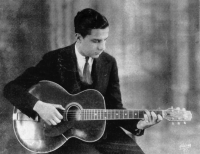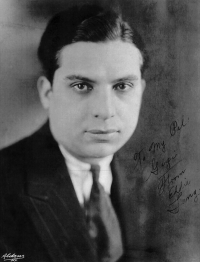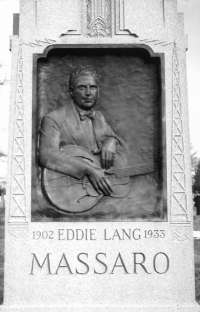
Volume 111(11) November 2001 pp 1980-1983
Jazz and Otolaryngology: The Death of Guitarist Eddie
Lang
[Independent Papers: Historical Vignette]
Mandell, David L. MD
From the Department of Otolaryngology,
Mount Sinai School of Medicine, New York, NY, U.S.A.
Editor’s Note: This Manuscript was accepted
for publication June 19, 2001.
Send Correspondence to David L. Mandell,
MD, Department of Pediatric Otolaryngology, Children’s Hospital of
Pittsburgh, 3705 Fifth Ave., Pittsburgh, PA 15213, U.S.A.
E-mail: david.mandell@eudoramail.com
Outline
INTRODUCTION
DISCUSSION
A Jazz History
A Medical History
A Medical Mystery
CONCLUSION
Acknowledgments
BIBLIOGRAPHY
Graphics
Fig. 1
Fig. 2
Fig. 3
INTRODUCTION
It is not every day that the performance
of an otolaryngological procedure
can impact the history of jazz music, but this is precisely
what happened on March 26, 1933. On that day, Eddie Lang,
the “father of jazz guitar”1 and a music legend in the
making, died at the age of 30 from complications following a simple
tonsillectomy. The story of Eddie Lang offers insight
into the colorful world of early jazz and serves as a painful reminder
that even routine surgical procedures may carry with them
the potential for catastrophe.
DISCUSSION
A Jazz History
Eddie Lang is credited with having created
the entire idiom of jazz guitar almost singlehandedly. 2 Before Lang, the
banjo represented the principal strummed instrument in
jazz orchestra rhythm sections, 2 owing to its relatively loud
volume. Lang’s career coincided with the advent of the
electric microphone, and his pioneering use of this device to
amplify his instrument elevated the guitar to a new status
and level of respectability in jazz, 3 rapidly making the banjo
obsolete. 2,3 Without any predecessor from whom to model
himself, Lang demonstrated to the evolving world of 1920s
jazz that the guitar was a desirable band instrument for
both live shows and studio recordings, 3 was a legitimate vehicle
for jazz solos, 4 and could be as effective as the piano
in accompanying singers. 3 Jazz critics have described Lang’s
impact on jazz guitar as “immeasurable,”2 his legacy to
jazz guitar as “colossal,”3 and his innovative techniques as
comprising “the basic vocabulary of jazz guitar.”4
Eddie Lang, the son of Italian immigrants
and the youngest of 10 children, was born Salvatore Massaro in South
Philadelphia on October 25, 1902. 5 Before he was old
enough to attend school, Salvatore was playing a homemade
miniature guitar crafted from a cigar box by his father,
a stringed-instrument maker. 5 The stage name “Eddie Lang” was
adopted from that of a basketball player Salvatore admired.
1
Lang was to become one of the busiest
jazz sidemen and studio musicians of the 1920s, playing with such jazz
and
blues greats as Joe Venuti, King Oliver, Jack Teagarden,
Benny Goodman, Louis Armstrong, Jimmy and Tommy
Dorsey, Bix Beiderbecke, Frank Trumbauer, and Bessie Smith
(Figs. 1 and 2). 1,2 He participated in many of the
leading bands of the era, including the Jean Goldkette
and Roger Wolf Kahn bands and the Paul Whiteman Orchestra.
1 He also performed in more interracial “mixed bands”
than any other white musician of his time. 4 His guitar was
omnipresent on recordings of the era, 1 and the Great
Depression did nothing to slow down his income, which has been
described as “phenomenal” for the time period in which
he lived. 2

Fig. 1. Photograph of Eddie Lang with his guitar, early 1920s.

Fig. 2. Publicity photograph of Eddie Lang, late 1920s. Inscription reads,
“To My Pal Gigi
From Eddie Lang.” “Gigi” probably refers to Joe Venuti, jazz violinist
and boyhood friend of
Lang.
Compared to the self-destructive tendencies
of many early jazz greats, Lang was a quiet, reserved personage and a
reliable worker who seldom drank, making his untimely
death all the more ironic. 3 Blues guitarist Lonnie Johnson
recalls Lang as being “the nicest man I ever worked with,”6
and jazz guitarist George van Eps has described Lang as “a
living definition of the word ‘gentleman.’”1 Lang was
not without his vices, however; he was a notorious pool shark and
an avid gambler. 3,7 Indeed, according to wife Kitty,
Eddie Lang’s last words were, “Get me a racing form—I want to
pick a winner.”1 It is believed that Lang was a regular
smoker of tobacco (personal telephone communication with E.
Massaro, nephew of Eddie Lang, November 27, 2000).
In 1929, while with the Paul Whiteman
Orchestra, Lang was introduced to an up-and-coming vocalist by the name
of Bing Crosby. 2 The close personal and professional
relationship that was to develop between these two men, while
opening new commercial potential for Lang, ultimately
set in motion the events that would lead to the guitarist’s death.
By 1931, Lang was working full time as Crosby’s personal
accompanist on Crosby’s theater shows, nightly radio
broadcasts, and recordings. 4 When Crosby signed a $300,000
five-picture deal with Paramount Studios, he insisted
Lang share the experience with him. Lang, playing guitar
accompaniment, appeared with Crosby in their only
Hollywood feature film together, The Big Broadcast of
1932. 4
For his next movie, College Humor, Crosby
not only wanted Lang in the film, but also wanted him to have a
speaking part. 1 Lang, however, had been suffering with
a chronically “low and hoarse” voice. 8 Despite Lang’s general
mistrust of medicine and aversion to doctors (characteristics
that Crosby attributed to Lang’s relative lack of education
and immigrant background), Crosby finally talked Lang
into seeking medical advice. 7 In the words of Bing Crosby,
“Many times afterward I wished I hadn’t.”7
A Medical History
Lang’s preoperative diagnosis is difficult
to discern. In the few references that exist on the topic, Lang has been
described as having “a chronically inflamed sore throat,”7
“laryngitis,”1 and “disorders of. . .the digestive system that
tormented him his whole life.”8 Could Lang’s hoarse voice
have been a sequela of undiagnosed gastroesophageal
reflux? We may never know. Regardless, a tonsillectomy
was advised. Lang’s family was assured that it was to be “an
extremely simple operation.”8 On Lang’s death certificate,
under the heading of “diagnosis during last illness,” are
written the words “operation for recurrent tonsillitis/chronic
tonsillitis.”
The tonsillectomy was performed the morning
of Sunday, March 26, 1933, at Park West Hospital at 170 West 76th
Street in Manhattan. 8 Presumably, general anesthesia
was used. 7 Lang’s wife Kitty (a former Ziegfeld Follies dancer)
was present in the hospital at the time of the operation.
8,9 In the immediate postoperative period, the operation
appeared to have been a success. The surgeon reportedly
left, stating that everything had gone well. 8 Kitty Lang recalls
being told by the doctor that Eddie had been given a sedative
and would sleep for a while. 1 According to one
published reference, Kitty left to get something to eat,
and on her return found that Eddie Lang had died. 8 However, in
another source, Kitty claims that, despite the doctor
telling her to go home and come back later, she remained at Eddie
Lang’s bedside throughout the entire postoperative period,
waiting for him to awaken and see her. 9 Eddie Lang never
woke up. According to Kitty, after a nurse checked Lang’s
pulse around 5:00 pm, a doctor was rapidly called, and
Kitty was escorted out of the room, being told soon thereafter
that Eddie had died. Bing Crosby, who reportedly had
been at the nearby Friar’s Club, rushed to the hospital
after being notified of Lang’s death. 9 According to Kitty, “when
Bing found out, he cried in my arms like a baby.”1
The mechanism of death is uncertain.
In a 1992 interview of some of Eddie Lang’s living relatives by Italian
jazz critic
Adriano Mazzoletti, it was stated that Lang had “suffocated
on his own blood.”8 One relative suggested that Lang was
allowed to bleed to death because of inattention by the
nursing staff. 8 Could there have been a lack of staff because of
the operation being performed on a weekend? Another possible
contributory factor to Lang’s death may have been a
narcotic overdose, as the patient apparently never did
regain consciousness after having been given a postoperative
sedative. 9 Yet another theory as to the cause of death
centers around Kitty Lang’s claim that she had been told that
Eddie had developed “a blood clot that formed in the lung.”1
Indeed, on Lang’s death certificate, under the heading
“Contributory,” the words “coronary embolus” are written
and scratched out with a single line, followed by the words
“pulmonary embolus.” However, the accuracy of such a diagnosis
cannot be confirmed, as an autopsy was never
performed. 9 According to Kitty, “I didn’t want them to
cut him up anymore. . .Whatever had gone wrong, I felt I
didn’t want to know.”9
Lang’s body was transported to his hometown
of Philadelphia, where the funeral was held on Thursday, March 30,
1933 (Fig. 3). The event, which drew more than 2000 guests,
including many members of the jazz community, was
documented by a small obituary in the Philadelphia Record.
10 Eddie Lang’s death drifted into distant memory as
rapidly as Bing Crosby’s career rocketed toward uncharted
heights. Legal action was never taken. “I feel that a mistake
was made,” said Kitty, “but I don’t know for sure.”1

Fig. 3. Gravesite of Eddie Lang, Holy Cross Cemetery, Yeadon, Pennsylvania (year 2000).
A Medical Mystery
On review of the limited data regarding
the death of Eddie Lang, several questions emerge. First, where are the
medical records? New York City’s Park West Hospital, where
the surgery was performed, no longer exists; the site is
now occupied by an apartment complex. The hospital had
been a small (64- to 72-bed), private, for-profit institution
established in 1926. 11,12 During the time of Eddie Lang,
the hospital was reportedly frequented by celebrities who
required medical treatment and wished to protect their
anonymity (personal telephone communication with E. Massaro,
nephew of Eddie Lang, November 27, 2000).
In May 1976, 43 years after the death
of Eddie Lang, Park West Hospital, along with its sister institution Park
East
Hospital, filed for bankruptcy. 13 The hospitals were
officially closed by July 1977, 14 following repeated New York
State Health Department citations for health, change of
ownership, and building safety violations. 12 After Park West
Hospital was shut down, all medical records were retained
by a lawyer. These records were destroyed in a Brooklyn
warehouse fire, the exact cause of which was never determined
(S. Weinbaum, personal communication by written
letter to the author, January 17, 2001).
Another unsolved mystery regarding the
death of Eddie Lang is the identity of the operating surgeon. Kitty Lang
once recalled the doctor’s last name during an interview,
“Wolf,”8 but the doctor’s first name has remained undisclosed.
A 1934 American Medical Association physician roster lists
12 Manhattan physicians with the last name of Wolf, one
of whom is identified as an otolaryngologist, 11 but a
connection between any of these physicians and Eddie Lang
remains unproved.
Finally, why was the operation performed
on a Sunday, and not during the regular work week? The answer appears
to be related to the work schedule of Lang and Crosby.
According to a relative, Lang and Crosby had to return to Los
Angeles the following Wednesday and had already reserved
a train compartment. Lang was to be have the operation on
Sunday, leave the clinic by Monday, spend Tuesday with
his niece who would have just celebrated her fifth birthday,
then leave for California on Wednesday. 8 Needless to
say, events did not go according to plan.
CONCLUSION
The life of Eddie Lang, a pioneer in
the world of early jazz, ended suddenly and tragically at a time when the
young
musician had reached “the top of his profession”2 and
was poised to attain even greater commercial notoriety. Although
Lang is revered among jazz musicians and aficionados as
having been the first to establish the genre of jazz guitar,
remarkably little has been written about him. In 1958,
a quarter of a century after Lang’s death, jazz critic Herb Shultz
remarked: “. . .it is a little surprising that his tragic
death did not stir up a splendid jazz legend. All the storybook
elements were present. . .The legend of Eddie Lang—for
better or worse—never materialized.”5 The story of Eddie
Lang should be of interest not only to those in the jazz
community, but also to those of us in the medical community. His
case serves as a reminder to never overlook the potential
danger inherent in even routine surgical procedures. The name
of Eddie Lang deserves to be acknowledged both as a seminal
contributor to the world of jazz and a notable, tragic
patient within the rich tapestry of historical medicine.
Acknowledgments
The author thanks Marissa W. Mandell,
RPh, for her assistance with data collection and her translation of select
portions of Eddie Lang: Stringin’ the Blues8 from Italian
to English, and Mike Peters for his contribution of Kitty
Lang’s manuscript, 9 a photocopy of Eddie Lang’s death
certificate, and the publicity photographs of Eddie Lang, and
for reviewing the present report and confirming historical
accuracy.
BIBLIOGRAPHY
1. Ferguson J. Eddie Lang: father of jazz guitar. Guitar Player 1983; 17: 78.
2. Kienzle R. Great Guitarists. New York: Facts on File, 1985: 133–136.
3. Hadlock R. Jazz Masters of the Twenties. New York: The MacMillan Company, 1965: 239–255.
4. Sallis J. Eddie Lang. In: Sallis J, ed. Jazz Guitars. New York: Quill, 1984: 45–61.
5. Shultz H. Man with the blue guitar. Saturday Review. March 15, 1958:68–70.
6. Shapiro N, Hentoff N. Hear Me Talkin’ to Ya: The Classic
Story of Jazz as Told by the Men Who Made It.
New York: Holt Rinehart
& Winston, 1955: 271–273.
7. Crosby B. Call Me Lucky. New York: Simon & Schuster, 1953: 89–92.
8. Mazzoletti A. Eddie Lang: Stringin’ the Blues. Rome, Italy: Pantheon, 1997: 8–9.
9. Lang K. When Day is Done. Manuscript registered with Writer’s Guild of America, West, Inc. Los Angeles: Ms. 136497.
10. Notables attend Eddie Lang rites. Philadelphia Record. March 31, 1933:15F.
11. American Medical Directory, 13th ed. Chicago: American Medical Association, 1934; 1071.
12. Doctors’ aims questioned at 2 hospitals they own. New York Times. May 5, 1975:35.
13. Two hospitals file for bankruptcy. New York Times. May 14, 1976:B2.
14. 106-Bed park east hospital shuts; code violations,
money ills cited. New York Times. July 2, 1977:21.
Copyright (c) 2000-2002 Ovid Technologies, Inc.
Version: rel5.0.0, SourceID 1.6100.1.111